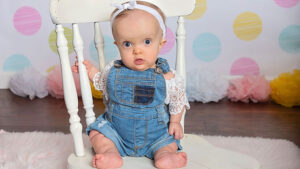You’ve probably seen “Little Couple,” “Little People, Big World,” or even “7 Little Johnstons” on The Learning Channel. These programs hope to take some of the mystery away from families with “little people,” who may have achondroplasia, much like our cover model Daisy this month, as well as give a glimpse into what life is like for Little People.
“Achondroplasia is the most common form of dwarfism, or disproportionate short stature that affects the way bones of the body develop,” says Anna Hurst, MD, medical geneticist at the University of Alabama at Birmingham and Children’s of Alabama. “It is one of many types of skeletal dysplasia, or differences in how the bones and skeletal system form.”
While it is not necessarily hereditary, it is a genetic condition that happens when there is a difference in the way a person’s FGFR3 gene is spelled. This gene gives instructions to the body about bone growth, Hurst explains. It can also be inherited from a parent who is affected with the condition, she adds, and it happens to about 1 in every 20,000 people. “If a parent has the condition, there is a 50 percent chance each of their children could have it. About 20 percent of people with achondroplasia have a parent with the condition, and in the other 80 percent it is a new genetic change,” Hurst adds.
In Daisy’s case, she has one parent, her mother, with the gene. Bailey, Daisy’s mom, was born with it, “but we had no history of dwarfism in our families,” says Daisy’s grandma and Bailey’s mom Laura Rogers, a registered nurse. “For most families such as ours, it’s what’s called a fresh mutation’ meaning it just happened.
“A gene mutation at conception,” Rogers adds. “I say we were blessed.”
“Because Bailey married an average sized man, we knew there was a 50/50 chance of it being passed on,” Rogers says. “We found out at about 22 weeks that Daisy had the gene.”
Babies with achondroplasia may have some special needs, Hurst says. They may have sleep apnea or narrowing in the back of the skull that pinches where the brain and spinal cord travel. These can be serious….so early monitoring is very important, and some people may need surgery.
“They may develop a build-up of fluid in the brain called hydrocephalus. Over time, they can have frequent ear infections and problems with the bones of the spine, hips and joints. Some children can have delays in their development, but most people have ‘normal’ intelligence as an adult,” Hurst explains.
“Some children may benefit from early developmental therapies, like speech, physical and occupational therapy. At home parents may need to pay attention to how their car seats, bathrooms, toys and clothes are safe and adapted to make them easy for the child to access,” Hurst says. The same will be true for the classroom setting.
“In our home, when Daisy’s mommy was younger, we never said ‘growing up,” Rogers recalls. “I supposed because I knew she would never really grow up in height. We always said, ‘when you get older.’
There are definitely other obstacles to children (and adults) with Achondroplasia. “She (Daisy) faces public staring and discrimination,” Rogers explains. “Even now, her mommy, my daughter, is still stared at. People take pictures of her. As a mother, you never get over this. As Daisy’s grandmother, I cannot imagine I will be any different.”
“There are offensive words that are still used to describe a person with dwarfism,” Rogers explains. “’Midget’ is a huge no-no. The preferred term is ‘Little person’ or ‘person of short stature.’”
It is important to mention that achondroplasia is just one type of skeletal dysplasia – there are more than 400 different types, but others are usually rarer, Hurst adds. “If you are concerned about how your child’s height or bone development, talk to your pediatrician to see if they should be evaluated by a geneticist.”
“I see beauty when I look at Bailey and Daisy,” Rogers says. “I don’t see a disability. I see the loves of my life when I look at them….and I would so much rather answer your questions and educate you rather than have someone stare, point or laugh.”
“There is a national support group called Little People of America. It was started by the actor Billy Barty in 1957, and each year they have a national convention, followed by the Dwarf Athletic Association of America Olympic games. The Birmingham chapter is called the Magic City Chapter of Little People of America, Rogers says.
“Daisy is the biggest little girl I know,” Rogers explains. “Though she is little, she is fierce. I told her mommy back when she was younger, and I will tell Daisy the same thing – ‘God doesn’t make mistakes.’ What a boring world it would be if we were all the same. God knows exactly who to give special children to,” Rogers adds.
Carol Muse Evans is publisher of Birmingham Parent.





